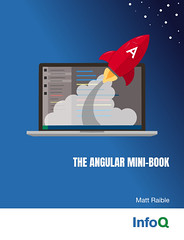I'm sitting at the Denver JUG
meeting and Joshua Bloch
and Neal Gafter just finished a talk on "Java
Puzzlers". I didn't show up until halfway through - but it was still a
great half hour. They had a bunch of slides with problems that had
seemingly easy answers. They'd both have a good dialog about their
proposed answers - and then asked the crowd what they thought. The
problems were mostly due to dumb (but real world mistakes) - the kind of
thing you'd slap your fellow programmer for writing. These guys are
definitely fun to listen to - next up is Tiger and what's new in 1.5 (I
thought it was 5.0?). Boy, it's a full room tonight - I'd bet there's
around 120-150 people here.
Taming the Tiger
Major theme of "JDK 5" is ease of development with features like generics, for-each loop,
autoboxing/unboxing, enums, varargs, static imports and annotations.
It's designed to make programs clearer, shorter and safer by providing linguistic support for commong idioms. Sidenote:
Joshua said that Neal wrote the compiler - and they've basically made it more rigorous so it writes
the boilerplate code for you. New features do no sacrifice compatibility or
compromise the spirit of the language. Neal has been using these features for a couple of years now and
he says he's really enjoyed them.
Goal of this talk is to make it easy for us to understand JDK 5 so we can start using it in our development. Let's look at the different features of 5.0.
Generics, For-Each and Autoboxing/unboxing
Generics allow you to specify the element type of collection. Rather than specifying a List - you specify
it's contents - i.e. String. It's basically stronger typing with less typing which enforces the specification
at compile time. For example, the following code using the new for-each syntax to iterate through a list of TimerTasks
in a collection. Notice the lack of casting and easy-to-read loop syntax.
void cancellAll(Collection<TimerTask> c) {
for (TimerTask task : c) {
task.cancel();
}
}
Bytecode is the same as it is in 1.4 - 5.0 merely converts the code for you. One question that these guys
have heard a lot is why ":" rather than "in". The answer is twofold - because "in" is already
a keyword (for example, System.in) and they didn't want to introduce a new keyword. Because 'in' is an identifier that is already in widespread use, and thus they could not make it a keyword without serious impact. Only new
keyword in JDK 5 is enum.
The Collection Interface has been Generified. All existing code should still work, but you
can also use the new stuff if you like. I haven't listened much to what's new in 5.0 - but this is
wicked cool. You might say it sucks because now you end up with strongly typed stuff, but at least
you won't have any more ClassCastExceptions.
- autoboxing: automatic conversion from int to Integer (or from double to Double, etc.)
- unboxing: automatic conversion from Integer to int
For example, you can now easily do the following:
Integer i = new Integer(5);
Map map = new HashMap();
map.put("result", i+1);
Notice that the Integer type is converted to an int for the addition, and then back to an Integer when it gets
put into the Map. Cool, huh?
JDK 5 also simplifies reflection. Class Class has been generified -
Class literal Foo.class is of type Class<Foo>. This enables compile-time
type-safe reflection w/o casting. The following used to return an Object and required casting.
Foo foo = Foo.class.newInstance();
This enables strongly typed static factories. I wonder if this can be
used with Spring so you don't have to cast a bean when grabbing it from the ApplicationContext?
When should you use Generics? Any time you can - unless you need to run on a pre-5.0 VM. The extra
effor in generifying code is worth it - especially b/c of increased clarity and type safety.
When to use for-each loop? Any time you can b/c it really beautifies code and makes it much
easier to write. It's probably the smallest new feature in 5.0, but likely to be a favorite.
You can't use for-each for these cases:
- Removing elements as you traverse a collection (b/c there's no iterator)
- Modifying the current slot in an array or list (b/c the index is hidden)
- Iterating over multiple collections or arrays
The lack of an index seems to rub the crowd wrong. Joshua and Neal's response is they tried to
design something very simple that would capture 80% of usage. If you need an index, just use
the old for loop - it ain't that hard; we've been doing it for years!
If you want to use for-each in your APIs - i.e. if you're writing a framework, a class should implement
the new Iterable class.
When should you use autoboxing? When there is an impedance mismatch b/w reference types
and primitives. Not
appropriate for scientific computing. An Integer is not a substitute for an int. It simply hides
the distinction between wrappers and primitives. A null unboxes by returning a NullPointerException.
They did consider setting it to the primitive's default, but the community voted 50-1 to for NPE.
Enums
JDK 5 includes linguistic support for enumerated types. Advanced OO features include the ability to
add methods and fields to enums. Much clearer, safer, more powerful than existing alternatives (i.e. int enums).
enum Season { WINTER, SPRING, SUMMER, FALL }
I just noticed that it's boiling in here - A/C must be out again in the auditorium. It's 8:20 right
now, I hope this is over soon, I can feel sweat beading on my forehead.
Enums are Comparable and Serializable. Enum constants should be named similar to constants. Enums are basically
a new type of class. As far as I can tell, I have no use for Enums in my code. There's lots of gasps
from the crowd as Joshua is describing the features of Enums (i.e. constant-specific methods). Sure
it looks cool, but I still don't think I have a use for it. Maybe framework developers will find this
useful. BTW, there's two high-performance collection classes: EnumSet (bit-vector) and EnumMap (array).
EnumSet replaces traditional bit-flags: i.e. EnumSet.of(Style.BOLD, Style.ITALIC).
When should you use Enums?
-
Natural enumerated types: days of week, phases of moon, seasons
-
Other sets where you knkow all possible values: choices on menus, rounding modes, command line flags
-
As a replacement for flags (EnumSet)
Quote of the night: "It's extraordinarily rare that you'll need to cast when programming with JDK 5".
Varargs
A method that takes an arbitrary number of values requires you to create an array. Varargs automates
and hides the process. James Gosling contributed the ... syntax. Varargs always has to be the last
parameter. MessageFormat.format has been retrofitted with varargs in JDK 5:
public static String format(String pattern, Object... arguments);
String result = MessageFormat.format("At {1,time} on {1,date}, there was {2} on planet "
+ "{0,number,integer}.", 7, new Date(),
"a disturbance in the Force");
Reflection is now much easier with Varargs - so you can call c.getMethod("test").invoke(c.newInstance())
instead of c.getMethod("test", new Object[0]).invoke(c.newInstance(), new Object[0])).
When should you use Varargs?
-
If you're designing your own APIs - use it sparingly.
-
Only when the benefit is compelling. Don't
overload a varargs method.
-
In clients, when the API supports them: reflection, message formatting, printf
Static Imports
Clients must qualify static members with class name (Math.PI).
To avoid this, some programmers put constants in an interface and implement it. BAD - "Constant Interface Antipattern".
They've made this mistake in the JDK - java.util.jar has this pattern. Static import allows unqualified access to
static member w/o extending a type. All static fields, methods, etc. will be available for your
class using static imports. For example:
import static java.lang.Math.*;
r = cos(PI * theta);
When should you use Static Imports?
- Very sparingly - overuse makes programs unreadable.
- Only use it when tempted to abuse inheritence.
Metadata
Decorates programs with additional information. Annotations don't directly affect program semantics. They *can*
affect treatment by tools and libraries. Can be read from: source, class files, or reflectively. Ad hoc examples:
transient, @deprecated. Tiger provides a general purpose metadata facility.
Why Metadata?
- Many APIs require a fair amount of boilerplate - i.e. JAX-RPC.
- Many APIs require "side files" to be maintained. Examples: BeanInfo class, deployment descriptor.
- Many APIs use naming patterns, i.e. JUnit.
Metadata encourages a declarative programming style - tell a computer what to do, now how to do it.
Annotation Type Declarations are similar to interface declarations.
Special kinds of annotations include Marker annotations and Single-element annotations.
The main reason for annotations is for tools providers.
Neal thought that JDK 5 Beta 3 or Release Candidate was available at
http://java.sun.com/j2se/1.5.0, but it looks like Beta 2 is the latest release. The fact that he said that implies that a new release should be available shortly. Neal
also mentioned that JDK 5 (final) would be shipping soon.
Random fact:
Google uses a lot of Java - entire Ads front-end is done in Java.
This was a great talk about all the new features of JDK 5 - I can't wait to start using them. It might be awhile before
I can convert AppFuse to JSP 2.0 and JDK 5, but it'll be a good day when I can write my apps using these technologies. Tonight was the best overview of JDK 5 that I've seen so far - in print or person.
Update: Presentations PDFs have been published: Programming Puzzles and Taming the Tiger.


 :
:
 Finally, I can confirm that SiteMesh rocks - it worked for all the frameworks I used and I never had to change a single line of code.
Finally, I can confirm that SiteMesh rocks - it worked for all the frameworks I used and I never had to change a single line of code.
